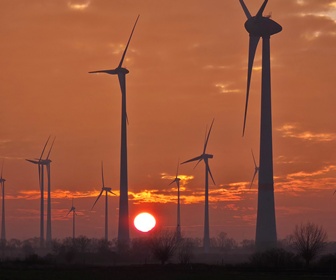 Predicting the status of wind turbines now for 80 years in the future can be not much different from predicting the future of home computers in 1950 for 2004. You can see the latter in Figure 1 and observe such a prediction to be far from reality.
Predicting the status of wind turbines now for 80 years in the future can be not much different from predicting the future of home computers in 1950 for 2004. You can see the latter in Figure 1 and observe such a prediction to be far from reality.By Ahmad Hemami, McGill University, Montreal, Canada
Nonetheless, we can always see the trend and come up with some idea about progress and where that trend is heading. In 1927 an intellectual individual, based on the status of the telephone at the time, foresaw in his book a future when we could communicate with each other while seeing an image of each other and that we could attend schools where students do not need to be physically present or even in the same city as the schools or teachers. Well, it has taken less than 100 years for these to become reality.
It is likely that by 2100 there is no longer a fuel called fossil fuel (oil and gas). Therefore, not only are all cars electric, all other types of transportation and heating of houses also use electric energy. If there are cases that must use a combustion engine, they use hydrogen as the fuel. Air traffic may be very different by then and its fuel/power requirements not as they are today. If there is any crude oil left, its application is for manufacturing purposes only, making plastics, lubricating oil and so on.
In this future, the main sources for generating electricity are wind, solar, wave, tidal and hydro energy plus nuclear energy. Geothermal energy contributes to local generation, whereas all the renewable energy sources provide a considerable percentage of the energy demand.
As far as wind turbines are concerned, we can guess that they maybe provide 20% of the total world energy need. This implies a continuation of the progress in their technology and increase in their share of energy production.
Turbine size has finally reached a limit and is staying there. Probably all these turbines are of the vertical axis type, not necessarily like those that we have seen so far. It can be envisaged that by the 2100 era there are not many onshore wind farms. On the contrary, there are vast corridors of offshore turbines stretching into the sea for much longer distances compared with today’s status. Some may cover the whole distance between the mainland and the nearby islands, or between neighbouring countries. These corridors are along the pathways of cargo and other ships, including the service ships for wind farms.
We can envisage that the hurdle of the deep sea is eased by the following:
- The position of turbines in deeper water is controlled by using the Global Positioning System to keep each platform in place. There is no need to anchor the platform to the seabed.
- There is no need for seabed cables for transmission of power to land. Transmission is carried out via highly tuned, directional, through-air, power transmission send/receive facilities. A number of these transmission facility stations bring the collected power from each wind farm to the shore through dedicated pathways that are reserved for this purpose and must be avoided by any air traffic and other through-air communications.
These two elements are instrumental to wind power and wave and tidal power generation and can be shared by them.
On other fronts, electricity can be provided/supplemented to a destination by portable storage systems that can be easily transported like a huge battery in tens of megawatt sizes. Possibly at that time the charged units are transported from offshore power stations to the shore by rapid trains that move in submerged tunnels along the corridor of energy farms. The loading station islands are also floating, like a lot of man-made industrial and amusement islands.
But who is going to witness this? Certainly not the majority of adults who are alive now, perhaps some of today’s kids. Mostly, only those who are dealing with energy production at that time will know the history behind their ‘energy’ supply.










